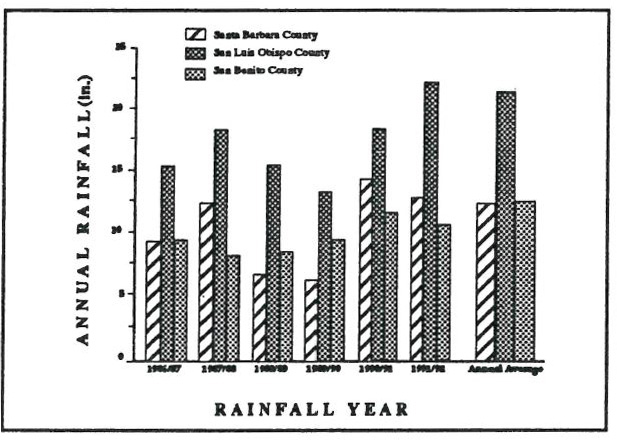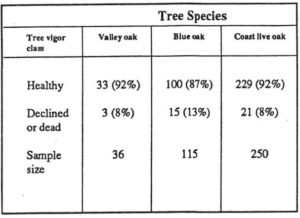Oaks ‘n’ Folks – Volume 8, Issue 2 – November 1993
Introduction
With the “miracle March” of 1992 and the “fabulous February” coupled with generally excellent rains of 1992/93, it appears one of the most severe and widespread California droughts this century may be over. But the effects of the drought in many plants on California’s oak woodlands may be far reaching and long term. This is obvious over landscapes where catastrophic drought-induced wildlife occurred. It may be less obvious over thousands of oak woodland landscapes unaltered by fire. The past several years, however, UC Cooperative Offices have received numerous reports from ranchers, ranchette owners, and land managers that native oak trees on their lands have died. Although native oaks are well adapted to periodic drought, the severity of the latest drought has apparently resulted in the decline and death of many trees.
The six-year drought (1986-87 to 1981-92) coincided with an ongoing study of acorn production of valley oak, blue oak, and coast live oak on permanent plots in Santa Barbara, San Luis Obispo, and San Benito Counties. Each fall, 1988 to present, we recorded mast production of the trees on the plots along with several other variables, including the status (partially or completely dead, or healthy) of each tree on the plots. This article reports the number of trees which severely declined or died during 1988-92. Results of other measurements are not reported here.
Figure 1 graphically shows the average rainfall for each county during the drought compared to the long-term average. Total rainfall averaged 16% below normal for Santa Barbara and 26% below normal for San Luis Obispo and San Benito Counties during the drought.

During summer and fall 1988, in Santa Barbara, San Luis Obispo, and San Benito Counties, stands of blue oak, coast live oak, and valley oak were located. Within these stands, tenth-acre plots were established randomly at least 200 feet from roads which traversed the stands. Plots without at least 10% oak canopy cover and three oak trees four inches dbh (diameter at breast height, or 4.5 ft. from the ground) were excluded.
Thirty-five plots were established, about an equal number in each of the three counties. All plots were located on oak woodland grazed by cattle. Within the plots, the trunk of single-trunked oak trees and all the stems of multiple-trunked oaks over four inches dbh (all referred to as “trees” in this article) were marked in 1988 with numbered aluminum tags for permanent identification. A total of 401 trees (36 valley oak, 115 blue oak, and 250 coast live oak) were marked; all marked trees appeared alive and healthy.
In late August to October 1988, the species, tag number, dbh (in), height (ft), and dominance (i.e., whether the tree was growing under the canopy of other trees [suppressed] or whether it formed the canopy [dominant] were recorded for each marked tree along with the aspect of each plot. The status of trees that appeared severely stressed or dead was evaluated subjectively by examining bark and small branches for dryness and brittleness. We classed these trees as “partially dead” if at least 50% of the tree was brown and leafless or “completely dead” if the entire tree appeared brown and leafless. All other trees were classed “healthy.”
Results
Tree Mortality

Partial or complete mortality of certain trees on the plots began to show up in late summer and fall 1990. By 1992, nearly 10 percent of the 401 trees on the 35 plots were either severely declined or completely dead (See Table 1). None of the three oak species escaped the drought; the drought took about equal toll on each.
Tree Characteristics
Tree size: Smaller blue oak and coast live oak trees succumbed (partially or completely dead) to the drought more than larger trees. In contrast, partially or completely dead valley oak trees were larger than healthy trees but this may have been due simply to the relatively small number of valley oaks examined.
Dominance: For valley oak and blue oak, dominance status did not seem to be a factor in whether the tree was affected by the drought. For coast live oak, on the other hand, proportionately more partially dead or completely dead trees were suppressed. This between-species difference probably was due simply to the dense stands of coast live oak used in this study compared to the relatively open stands of valley and blue oak.
Slope Aspect Effects
Analysis of plot data revealed that slope aspect (north, south, east, or west) of the plots made a difference in whether the trees were adversely affected by the drought. Proportionately more partially or completely dead trees were on plots that faced south.
Conclusions
Little information is available on annual mortality rates of California oak trees. The high level of decline or death of oak trees recorded during the drought, however, was apparently not typical of California oak stands during times when fire, insect infestation, severe drought, or other catastrophic events do not occur. According to Chuck Bolsinger, Research Forester, Pacific Northwest Research Station, it is higher mortality than the Research Station recorded as pat of a long-term inventory of oak trees on sample plots in California.
The six-year period of 1986-87 to 1991-92 was the driest this century for most parts of California. The effect on the central coast was even more severe than for other areas in the state. We still cannot pin the high rate of mortality of native oaks to the drought. Several circumstances, however, surely point to the drought as the culprit. First, our field observations did not give reason to suspect other potential mortality factors, such as insects or pathogens. In this study, significantly higher tree mortality on south slopes further implicates the drought. South slopes typically are drier and have shallower, more infertile soils than other aspects. These conditions would be expected to be exacerbated by severe drought. Third, in many areas of oak woodland during the drought, blue oaks lost their leaves in August, about three months “ahead of schedule.” Researchers attributed early leaf fall to tree stress due to depleted soil moisture. Finally, many ranchers reported the occurrence of dying and dead trees on their lands during the drought years. These reports were often accompanied by statements as, “I have never seen oak trees die like this before.”
High mortality of oak trees during periodic severe drought may simply be nature’s way of regulating the distribution and abundance of oak sin California. However, anthropogenic stresses placed on California native oaks over the past 100 years have resulted in poor regeneration of some species and increased removals. Coupled with these stresses, drought stress may be one more reason that we need to be careful and wise in our decisions relating to oak woodland. Plot trees will continue to be monitored for at least several more years to further evaluate the effects of six years of drought on native California oaks.
prepared and edited by John M. Harper, Richard B. Standiford, and John W. LeBlanc
